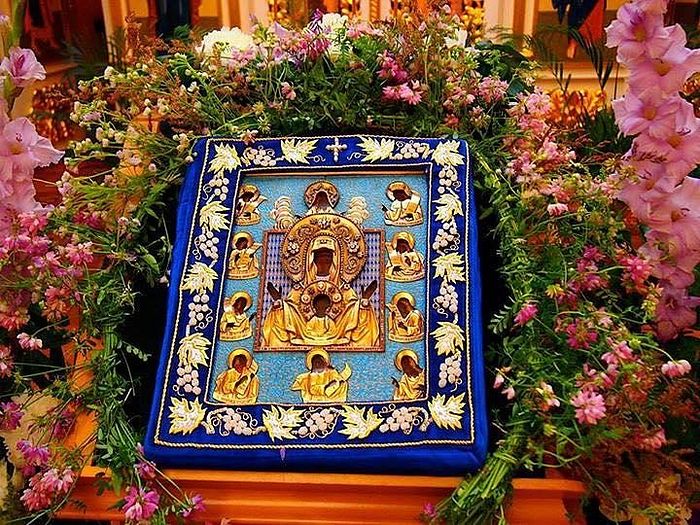Source: St. Louis Public Radio
May 8, 2016
Several Orthodox Christian churches in the St. Louis area are hosting a centuries old icon over the next few days.
The Kursk Root Icon is a painting of the Virgin Mary, known as the Theotokos, that is said to date to the 13th century in its namesake town in Russia. The icon, associated with miraculous healings and events, annually travels to the North American parishes that are part of the Russian Church Outside of Russia (which is now a reconciled part of the Russian Orthodox Church).
It recently visited the Assumption Greek Orthodox Church in Town and Country and St. John Chrysostom Church in House Spring. On Saturday morning, it will be hosted at the Dormition of the Theotokos Church in Bendl, Illinois. It will then stay at St. Basil the Great Church in Des Peres through Sunday morning.
Father Martin Swanson of St. Basil's said the icon is associated with so many miracles and cures "that they're almost too numerous to mention in any reasonably sized book."
He described a few for St. Louis Public Radio:
Its discovery
After the village of Kursk was destroyed by an invasion, two hunters noticed something strange at the base of a tree. It was a painting of Jesus' mother, Theotokos, also known as the Virgin Mary. The hunters took the icon to the nearest cathedral, but by the next morning it had disappeared. Later, they found it sitting at the base of the same tree where it was found.
The hunters removed it again, only to find it again at the base of the tree. When the icon was picked up, a stream began to come out of the ground. This was taken as a sign that a chapel should be built in that spot, and in time, people came to the chapel to venerate the icon and "more miraculous events began to occur like healings," Swanson said.
Chopped in two
A city grew around the chapel where the icon was held, but again it was attacked by invaders who burned the church and took the icon, hacking it in two and tossing it into ditches on either side of the road. The chapel's priest, who managed to escape the invasion, came back to look for the icon's remnants. Once found, he held them together and they instantly bonded back into one piece.
"To this day, if you look at the icon, you can see the - I guess I'd call it - a scar, where the icon had been cut in two," Swanson said.
Nearly blown up
Years before the Russian Revolution, Swanson said a group of Bolsheviks and communists targeted Kurst's Cathedral of the Sign, where the icon was being housed. The group placed dynamite in the Cathedral in an attempt to destroy the icon and blew the church up in the early morning hours. All the windows of the Cathedral were blown out and its metal doors landed more than a hundred feet from the shrine, blown off its hinges.
But the icon remained undamaged.
The icon travels
After the revolution, the then head of the Russian Orthodox Church, Patriarch Tikhon of Moscow ordered bishops to escape from being persecuted by the Bolsheviks. The diaspora saw Russians go to Germany, Shanghai, Constantinople, Serbia and other locations. But all the while, the icon traveled with them and was considered "the protection of the Russian people who had escaped," Swanson said.
In 1922, the Russian Orthodox Church Outside of Russia separated from the patriarchate in Moscow, due to its control by communists. The ROCOR established itself in New York, where the icon resides to this day.
In 2007, the ROCOR reconciled with the Moscow Patriarchate of the Russian Orthodox Church. Two years later, the icon returned to Kursk's cathedral and almost 300,000 people came to venerate it. It now returns to Kursk annually, attracting even larger crowds each time. It also travels annually to the Orthodox parishes around North America.
Modern experiences
Swanson said a couple of years ago, he heard that a young woman who was paralyzed prayed in front of the icon while it was at the Assumption Greek Orthodox Church and she "received healing."
Swanson also recounted an experience he had when watching over the icon in his home. The Kursk Root Icon is not considered to be "myrrh-bearing" - or a class of icons that exude a fragrant scent of myrrh "through no explainable reasons," he said. Yet while the icon was in his home, he and his wife were awoken in the early hours one night by a "very strong, very fragrant and delicious" scent that permeated their whole home.
"The icon was just pouring forth this whole fragrance," he said. "The next morning, it was gone."





There is an important typo in the article.
It was 1922, not 1952, that
ROCOR (Russian Orthodox Church Outside of Russia)
not RCOR Russian Church Outside of Russia)
separated from the Moscow Patriarchate.
Elena Stoyanova